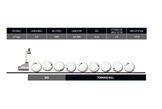The anatomy of the perfect putt
Published: Last updated:
There isn’t one perfect way to hit a putt – just like drivers or irons, every golfer has their own unique way of presenting a putter to the ball and launching shots across a green.
Everyone’s numbers are different – the real skill comes down to a fitter’s ability to find a way to compliment your natural stroke, with a putter best suited to it.
With putting launch monitors fast becoming the norm, and sophisticated software that captures hundreds of images per second to reveal exactly how a putt behaves at impact, and rolls across the green’s surface we thought it was time to find out what constitutes a good putt, and give an idea of what a launch monitor’s numbers tell you. Just like a driver or iron fitting there’s a bit more to it than you think.

Impact:
Thanks to launch monitor tech like Foresight Sports’ GC Quad, you can now see where every putt impacts the putter face; it’s the same technology TaylorMade used on woods when they came up with TwistFace. Knowing where you typically impact putts on the face is crucial; you really want to keep an eye on deviation to maximise consistency.
Face Angle:
Self-explanatory; ideally it should be as close as possible to 0°. A square face angle means you’re back to pointing the putter blade at the target you aimed at. Over 90% of the start direction of a putt is determined by face angle at impact… so it’s important to get yours as square to your target as possible.
Launch Angle:
To get the ball rolling smoothly you need to impact putts on the upstroke, but ideally by no more than 1.5°. You definitely don’t want to hit putts with a downward stroke.
Ball speed:
It’s highly likely, like us, you’ll see a difference in ball speed switching between insert and non-insert putters, but the fact there’s a difference isn’t important. What is crucial is looking at deviation. For consistency it wants to be as low as possible. Poor numbers see more than 1mph difference, while an elite player can expect a deviation of less than 0.35mph.
Launch spin:
Every model involved in our grooved putter test came out with averages of topspin, but some golfers will get backspin (it all depends on your technique), which isn’t ideal if you’re after true, smooth-running putts. Measured in rpm just like a driver, the higher the forward number you can get the better.
Skid:
When a putt is skidding it’s not rolling, and the idea is to get putts rolling as quickly as you can. Look to get skid as low as possible. Deviation is key – where very average club golfers might see a difference of more than 15in in skid (on a 10-12 foot putt) between putts, elite players can reduce skid differential to less then 2in.
Efficiency or Smash Factor:
Just like a driver, each putt is awarded a measure of how efficient it was hit. What you’re looking for here is consistency, and as tight a deviation as you can get your hands on.
Angle of attack:
As we’ve said you ideally want to hit putts on the up; this is where you get to see if your stroke is up to it. Downward strokes can jump putts off the turf, causing inconsistency.
Deviation:
The amount of difference between your best and worst (or lowest and highest) numbers in any particular category. It goes without saying the tighter the deviation, the more consistent you are, so pay attention to deviation numbers during a fitting.




